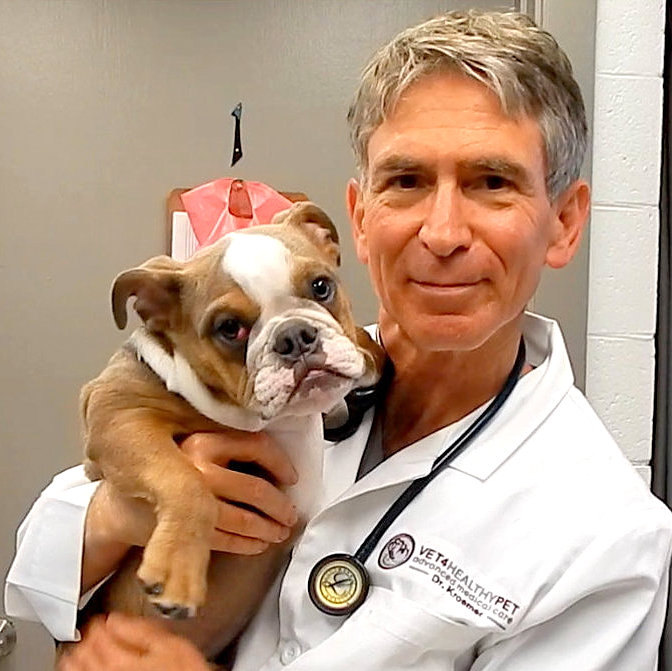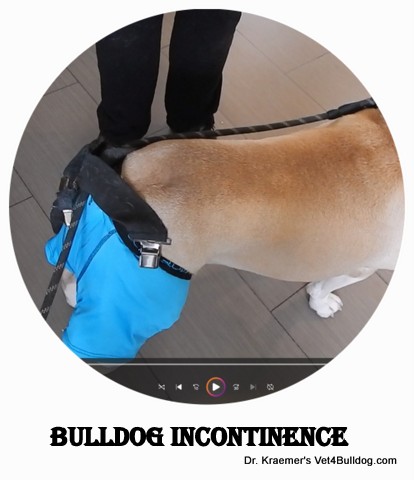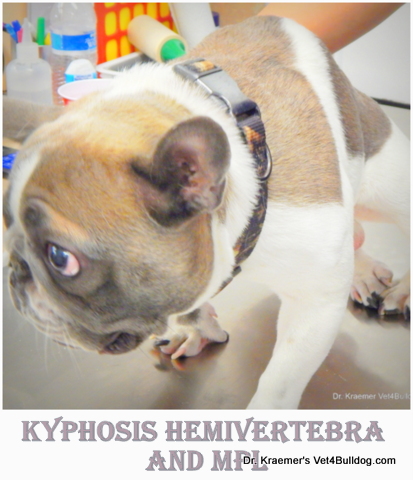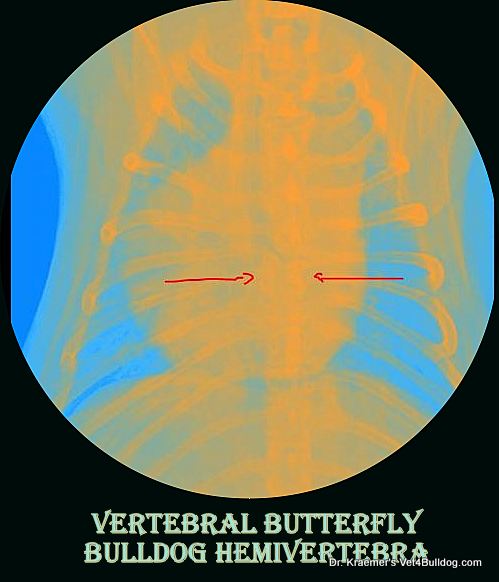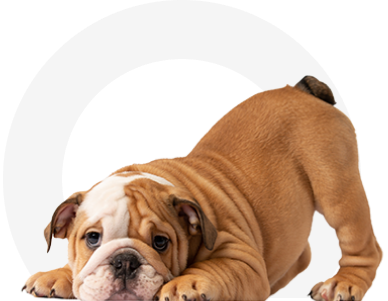“Dr. Kraemer, I’m really worried about my Bell. Lately. She seems to be having difficulty moving her hind legs and is showing signs of pain. There’s an unsteady gait, and she’s reluctant to jump onto the couch or go up and down stairs like she used to. Sometimes, she lets out little yelps when I pick her up. It’s heartbreaking to see her like this. I’ve heard about IVDD in Bulldogs, and I’m wondering if that could be what’s going on. 😖🩺
Your expertise means the world to us. 🐾💔 #BellTheBulldog #IVDDConcerns”
Introduction to Bulldog IVDD
Intervertebral Disc Disease (IVDD) in bulldogs and French bulldogs develops when the gel-like material between the spinal vertebrae deteriorates, herniates, protrudes, and compresses.
🚨This protruding compression can injure the spinal cord, resulting in
- pain
- mobility difficulties
- incontinence
- and, in severe cases, paralysis.
EARLY DETECTION IS CRITICAL
French Bulldog IVDD Predisposition:
French bulldogs are genetically predisposed to IVDD due to their chondrodystrophic skeletal bone growth disorder features.
These anatomical attributes put additional strain on their intervertebral discs, increasing the risk of herniation.
IVDD IN YOUNG FR. BULLDOGS
Unlike other breeds where IVDD is typically seen in older dogs, French bulldogs can experience this condition as early as young adulthood.
The two most common locations of the bulldog and French bulldog IVDD are the
➡️ CERVICAL (neck )
➡️ THORACOLUMBAR (mid-section).

The Importance of Bulldog IVDD Early Detection
Early detection and prevention are critical.
A minor disc bulge with mild superficial spinal compression can often be treated with⚕️
- cage rest
- analgesics
- anti-inflammatories
- IVDD Supplements
-with the expectation of a full recovery.
⚠️ In contrast, ignoring the early signs could rapidly progress and lead to acute severe deep spinal compression that requires expensive emergency decompressive surgery that could result in irreversible neurological damage.
Bulldog IVDD 5 X MUST KNOW
- IVDD is more common in French bulldogs than in English bulldogs.
- Bulldogs with IVDD can present with a degree of mild to intense pain.
- Bulldogs with IVDD can exhibit mild motor, proprioception, and sensory deficits to severe surgical emergency ones.
- Treatment depends on severity; while mild cases require cage rest and RX, severe ones require immediate surgery.
- Prevention includes Dr. Kraemer’s IVDD Bundles
Members of this bulldog community prefer prevention over RX
Bulldog IVDD Spinal Cord Function
Your bulldog’s spine is the body’s neuro-superhighway, stretching from head to tail and carrying a constant stream of messages between their brain and body. Think about it as a two-way street, handling everything from playful jumps to the tiniest skin twitch.
The spinal cord travels from your bulldog’s head and brain to its pelvis and serves as the main neuro-highway for the upstream and downstream of neurological input and output that includes three major systems:
#1. WHAT ARE THE MOTOR NERVES?
The motor system acts as the conductor, sending electrical signals like sparks through nerves to muscles about how to move, when to contract, and when to relax, flex, and extend. The motor system powers everything from the powerful strides of a walk to chewing food and blinking.
#2. WHAT ARE THE PROPRIOCEPTION NERVES?
The proprioception neuro system tells your bulldog its body position at all times through sensors in muscles and joints; it’s like their body’s GPS. Imagine catching a ball, your bulldog will need to judge the distance, time the jump, and adjust mid-air, all thanks to the proprioception system.
#3. WHAT ARE THE PAIN AND SENSORY NERVES?
The pain sensory neurons alert your bulldog to potential harm. From a hot surface paw to a prick, the pain guides them away from danger, acting as a vigilant guard and ensuring their adventures stay fun and safe.
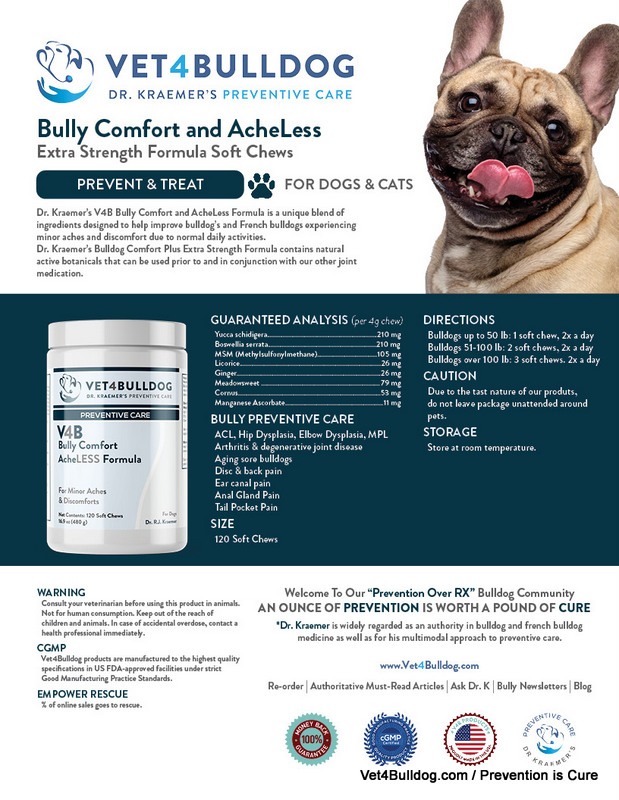
Bulldog IVDD Vertebral Column Function
The spinal vertebral column encompasses and protects the spinal cord. The bony vertebral bodies of the vertebrates shield the spinal cord as it passes through the spinal canal.
➡️ BULLDOG SPINE
The spine serves as a crucial part of the bulldog’s skeleton, protecting the spinal cord as it runs from the head to the tail.
➡️ SPINAL COLUMN:
The spinal column consists of four main sections:
- Cervical (neck)
- Thoracic (chest)
- Lumbar (lower back)
- Sacral (pelvis)
Each spinal section contains several pairs of vertebrae, connected by intervertebral discs
Bulldog IVDD Intervertebral Discs Function
These discs have a fibrous outer ring and a gel-like inner core, providing flexibility and stability.
- A shock absorber
- Allows for some movement of the spine.
The discs help hold the vertebrae together and act as shock absorber
IVDD in Bulldog and French Bulldogs: From Bad to Worse
Herniation of the intervertebral disc’s inner core (nucleus pulposus) through its outer fibrous ring (annulus fibrosus) can have several detrimental effects on the spinal cord and consequently inflict:
1. SPINAL CORD COMPRESSION :
The protruding disc material can directly compress and damage delicate nerve fibers in the spinal cord, leading to functional impairment and potentially permanent damage.
2. SPINAL CORD INFLAMMATION :
The body’s natural response to the disc herniation triggers an inflammatory reaction in the surrounding tissues, further impacting nerve function and causing additional pain.
3. SPINAL CORD SWELLING :
The inflammation contributes to swelling within the spinal canal, creating even more pressure on the vulnerable spinal cord and exacerbating pain and neurological deficits.
4. BULLDOG IVDD PAIN:
Ultimately, the combination of compression, inflammation, and swelling culminates in significant pain for the animal.
This pain can manifest in various ways, depending on the location and severity of the herniation, ranging from acute, sharp pain to localized discomfort.
🚨Clinical presentation depends on the severity of the injury and the trauma location (cervical, throacic, abominal, sacral).
How Do I Recognize a Bulldog IVDD Event?❓
Your bulldog might exhibit a wide range of conditions, from mild discomfort to severe pain, depending on the location, degree of bulging, and spinal cord injury. Listed below are some of the most common manifestations:
IVDD SYMPTOMS:
- Stiff Neck: Stiff, sensitive neck
- Crying: Crying out when touched around the neck or head movements
- Shaking
- Abnormal Posture: An arched back, hunched posture
- Abnormal Stance: A praying position with the head in a low stance
- Tense: Tense abdomen
- Weakness: Front and/or hind leg weakness, paw abnormal placement, lameness, and/or motor problems (paraplegia, paralysis)
- Abnormal Movement: Distress, reluctance to move, jump or walk upstairs
- Incontinent:
- URINATION: Difficulties in evacuating the bladder (larger than normal bladder), urine incontinence
- DEFECATION: Fecal incontinence
- Dragging & Knuckling: Dragging and knuckling the legs and paws
- Pain & Pain Loss: Lack of pain or oversensitivity to pain
- Wobbling: Wobbly, Ataxic gait
Bulldog Intervertebral Disk Back Disease Diagnosis
Your veterinarian will ask you leading questions about past and most recent events and proceed with observing, examining, and performing a few simple tests.
⚕️EXAM: Neurological Examination includes evaluation of mobility, muscle tone, pain, loss of pain, reflux, and toe placement
- Sensory Assessment: sensory nerve damage, including response to stimuli and pain perception.
- Proprioception Evaluation: the ability to sense body position and movements.
- Motor Function Assessment: motor nerve function, including strength, coordination, and ability to move.
⚕️IMAGING: allows pinpointing the herniated disc location and degree. Anestesia is often required
⚕️X-RAYS: Radiographs might attempted depending on the degree of pain.
⚕️MRI and CT: MRI is usually necessary for a final diagnosis and is the gold standard
⚕️MYELOGRAM: using a dye
⚕️LAB: Screening tests like blood and urine might be added
⚕️SPINAL TAP: for cytology and fluid analysis, culture is usually not required for IVDD but might be suggested if other neurological and back diseases are suspected
MRI is IVDD ultimate diagnostic tool and concidred the gold standard
How to Prevent Bulldog and French Bulldog IVDD?
There are a few steps you can take to prevent back injuries and IVDD
- Breeder: Buy from a reputable breeder.
- Weight: maintain lean body weight
- Activity: Keep your bulldog active, but avoid high-impact exercise (stairs, jumping)
- Cryobanking: You can save stem cells in a cryobank for such an event
- Therapeutic Bully Supplements
- 🌿V4B Bully IVDD Bundles
- 🌿 V4B Bully Fish Oil Joint-Skin-Immune
- 🌿V4B Total Joint Formula
How are Bulldog and Fr. Bulldog IVDD Treated?❓
A treatment plan would be proposed based on your veterinarian’s assessment.
1. TREATING A MILD IVDD
A mild case with no serious neurological deficits might only require short-term medication and strict cage rest.
🌿It can include therapeutic supplements such as
- V4B Bully Total Joint Advanced Formula
- V4B Bully Comfort & AchLess Chews
- V4B Bully Fish Oil EFA
- V4B HEMP Calm & Relax
- V4B Bully StressLess

Some cases might require
- pain medication
- anti-inflammatories
- and muscle relaxant prescription
Other non-RX therapeutics include:
- Cold Laser Therapy
- Pulse Electromagnetic Therapy
- Stem Cell Therapy
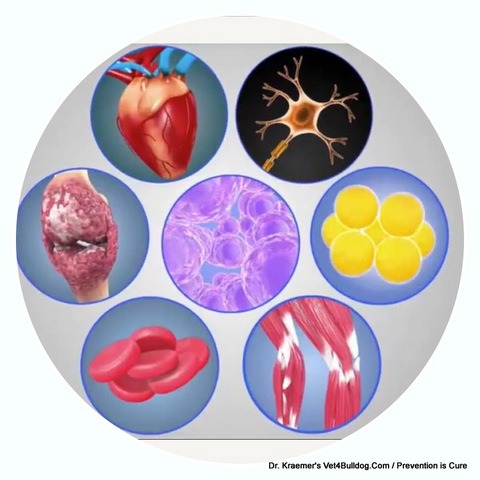
2. TREATING SEVERE BULLDOG IVDD
Loss of motor function, proprioception, and deep pain sensation are significant indicators of severe neurological damage. This situation warrants immediate attention and usually necessitates referral to a neurologist for thorough evaluation and management.
In many cases, surgical intervention is required to address the underlying cause and prevent further damage.
WHEN AN IVDD SHOULD BE REFERRED TO A NEUROLOGIST?❓
Your vet should be able to decide if your bulldog should be referred to the neurologist based on the neurological examination and imaging results and will discuss medical and surgical options with you.
WHEN BULLDOG IVDD SHOULD HAVE SURGERY?❓
The severity of the symptoms often determines the urgency of the surgery.
- 🚨Inability to Walk/Paralysis: Indicates severe nerve damage and often necessitates immediate surgical intervention.
- 🚨Loss of Deep Pain Sensation: A critical sign of severe spinal cord injury, making prompt surgery imperative to maximize the chances of recovery
Timely IVDD intervention is crucial for pets experiencing severe neurological symptoms.
Bulldog and French Bulldog IVDD Surgery
Surgery alleviates pressure on the spinal cord caused by herniated disk material or other compressive forces. The procedure involves removing the source of compression to restore normal spinal cord function and relieve pain.
Early surgical intervention often improves outcomes
BULLDOG IVDD SURGERY AFTER-CARE:
- Nursing and Care:
- Pain Control: Administer prescribed pain medications to manage discomfort.
- Confinement: Restrict movement to allow healing and prevent further injury. Use a crate or a confined space with minimal activity.
- Managing Incontinence:
- Diapers: Use diapers to manage urinary and fecal incontinence. Ensure frequent changes to maintain hygiene.
- Hygiene: Regularly clean the perianal and peri-vulvar areas to prevent scalding and infections.
- Antiseptic Wipes: Utilize products like
- 🌿 Dr. Kraemer’s Extra Large Antiseptic Wipes
- 🌿 Bully Antiseptic Lotion to help clean moisture, urine, and fecal material.
- Preventing Infections:
- 🌿 Urinary Health Formula: To protect against urinary tract infections by preventing ascending bacteria, administer a urinary health formula, such as Bully Urinary Health Formula.
- Probiotics: Use probiotics to support gut health, especially if antibiotics and steroids are used during treatment
- Botanical Fiber: Provides fiber to help soften stool and ease bowel movements.
- Mobility Support:
- Wheels with Lower Section Support: In cases of significant mobility impairment, consider using a wheelchair designed for dogs to aid movement and improve quality of life.
- Physiotherapy & Rehab: hydrotherapy, etc
Intervertebral Disk Back Disease (IVDD) in Bulldogs: PROGNOSIS
IVDD prognosis depends on the
- LOCATION: location of the injury
- SEVERITY: the severity of the hernia
- TIMING: how soon treatment was initiated
The longer the damage has been present, the worse the prognosis.
IVDD in Bulldogs and French Bulldogs TIPS & WARNINGS
Below is a short list of IVDD tips and warnings courtesy of Dr. Kraemer
#1 🩺IVDD CAGE REST TIP:
IVDD medical management requires strict cage rest for at least four weeks.
The rest is crucial to allow a “scar” to form over the top of the disc material.
Early activity may precipitate the herniation of the remaining disc material and worsen your dog’s condition

#1 ⚠️ BULLDOG IVDD URINATION PROBLEM WARNING:
#2 ⚠️ BULLDOG IVDD DEFECT PROBLEMS WARNING
Just as spinal injuries can impact bladder function, they can also disrupt your bulldog or French bulldog’s bowel movements due to damage to nerves governing bowel function. This can impede the ability to initiate and complete defecation, leading to:
Recommended by Owners Approved by Bulldogs



